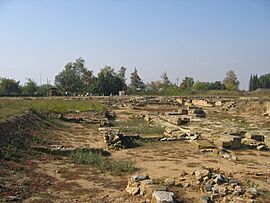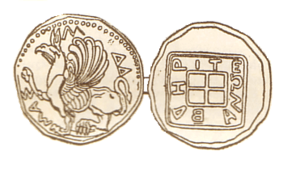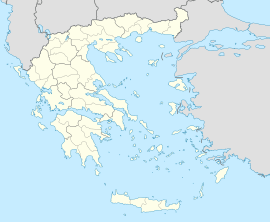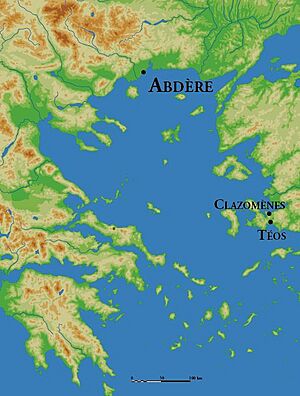Abdera, Thrace facts for kids
Quick facts for kids
Abdera
Άβδηρα
|
|
|---|---|

Remains of the ancient city of Abdera.
|
|
| Country | Greece |
| Geographic region | Thrace |
| Administrative region | Eastern Macedonia and Thrace |
| Regional unit | Xanthi |
| Area | |
| • Municipality | 352.0 km2 (135.9 sq mi) |
| • Municipal unit | 162.0 km2 (62.5 sq mi) |
| Elevation | 41 m (135 ft) |
| Population
(2021)
|
|
| • Municipality | 17,610 |
| • Municipality density | 50.028/km2 (129.57/sq mi) |
| • Municipal unit | 2,799 |
| • Municipal unit density | 17.278/km2 (44.749/sq mi) |
| Demonym(s) | Abderite, Abderian |
| Community | |
| • Population | 1,172 (2021) |
| Time zone | UTC+2 (EET) |
| • Summer (DST) | UTC+3 (EEST) |
| Vehicle registration | AH |
Abdera (Greek: Άβδηρα) is a municipality in the Xanthi regional unit of Thrace, Greece. Long ago, in classical antiquity, it was a very important Greek city, known as a polis, located on the coast of Thrace.
The ancient city of Abdera is different from the modern municipality. The old city was about 17 kilometers east of the Nestos River's mouth. It was built as a colony in an area of Thrace that wasn't part of Greece at the time. This colony grew into a very important city in ancient Greece. After the 4th century AD, it slowly became less important and was eventually left empty, except for archaeologists studying its ruins.
During the Early Middle Ages, a new town called Polystylon (Greek: Πολύστυλον) appeared near the ancient site. This new town was sometimes called New Abdera (Greek: Νέα Άβδηρα). In 2011, the modern municipality of Abdera was formed by combining three smaller municipalities. The ancient city's ruins are still part of this area. The municipality of Abdera has about 17,610 people (as of 2021). The main town where the municipality is based is Genisea.
Contents
Understanding the Name Abdera
The name Abdera comes from the ancient Phoenician people. This name was also used for other towns in ancient times, like one in Spain and another near Carthage in North Africa. The name was changed a bit by the Greeks and then by the Romans.
According to Greek legends, the name came from a hero named Abderus. He supposedly died nearby, and the hero Hercules built a city there to remember him. Today, the town is called Avdira (Άβδηρα) and is pronounced like "AHV-thee-rah" in modern Greek.
Abdera Through Time: A History
Ancient Beginnings
The Phoenicians likely started a settlement in Abdera before the mid-7th century BC. The town's coins for a long time used Phoenician designs.
The first attempt by Greeks to settle here was by people from Klazomenai, around 654 BC. However, the local Thracians drove these early settlers away. Later, the people of Abdera honored the leader of this first colony, Timesios, as a local hero.
Strabo, an ancient writer, described Abdera as a "Thracian city" when the poet Anacreon lived there. The successful Greek settlement happened in 544 BC. This was when most people from the city of Teos, including the poet Anacreon, moved to Abdera. They were escaping the Persian invasion of their homeland. The main design on Abdera's coins, a griffon, was the same as on Teos's coins. Abdera was known for its beautiful silver coins.
Persian Rule and Athenian Alliance
In 513 and 512 BC, the Persians, led by Darius, conquered Abdera. By this time, the city was quite important. It was even mentioned as one of the cities that hosted the Persian king on his way into Greece. In 492 BC, after the Ionian Revolt, the Persians conquered Abdera again. This time it was under Darius I, led by his general Mardonius.
After his defeat at the Battle of Salamis, the Persian king Xerxes stopped in Abdera. He thanked the people for their hospitality by giving them a golden crown and sword. Thucydides, a famous historian, noted Abdera as the western edge of the powerful Odrysian kingdom at the start of the Peloponnesian war. Abdera later joined the Delian League, a group of Greek city-states led by Athens. It fought alongside Athens in the Peloponnesian War.
Abdera was a very rich city. It was the third wealthiest in the Delian League. This was because it was a main port for trading with the inner parts of Thrace and the Odrysian kingdom. In 408 BC, Abdera came under the control of Athens.
Decline and Legacy

Abdera was a valuable city, and it was attacked many times. The Triballi sacked it in 376 BC, and Philip II of Macedon attacked it in 350 BC. Later, it was attacked by Lysimachos of Thrace, the Seleucids, the Ptolemies, and again by the Macedonians. In 170 BC, the Roman armies and those of Eumenes II of Pergamon attacked and looted the city.
The city's importance seemed to lessen after the mid-4th century BC. Some ancient writers even made fun of Abdera, saying its people were not very smart. For example, the Philogelos, an ancient joke book, has jokes about "dumb Abderans."
However, Abdera was actually home to many famous thinkers! These included the philosophers Democritus, Protagoras, and Anaxarchus. The historian and philosopher Hecataeus of Abdera and the poet Anacreon also came from Abdera. Pliny the Elder, a Roman writer, said that Abdera was a free city in his time.
Abdera was very successful in ancient times for two main reasons. First, it had a large territory. Second, its location was very important for strategy. The city controlled two major land routes: one along the Nestos River and another through the mountains north of Xanthi. Also, sea routes from the Troas region to the coasts of Thrace and Macedonia passed through its ports.
The ancient city's ruins can still be seen today on Cape Balastra. They spread across seven small hills. On the southwestern hills are the remains of the medieval town of Polystylon (Greek: Πολύστυλον). From the 9th century, Byzantine Polystylon was an important religious center. By the end of the 14th century, it came under the rule of the Ottomans.
Modern Abdera
The modern administrative area of Avdira (Abdera) was created in 1924. It included several villages. Over time, some villages became separate communities. In 1997, the municipality of Avdira was formed by combining several communities. In 2011, it merged with other municipalities, and the town of Genisea became its main center.
The municipality of Abdera covers an area of about 352 square kilometers. The municipal unit of Avdira is divided into smaller communities. The community of Avdira itself includes the settlements of Avdira, Giona, Lefkippos, Pezoula, and Skala.
Places to Visit in Abdera
Some interesting places to see in Abdera include the Archaeological Museum of Abdera, which shows artifacts from the ancient city. You can also visit the Kütüklü Baba Tekke, a historical building. For beach lovers, there's Agios Ioannis Beach, also known as Paralia Avdiron, near the village of Lefkippos.
Famous People from Abdera
- Democritus
- Protagoras
- Hecateus
- Nicaenetus
See also




